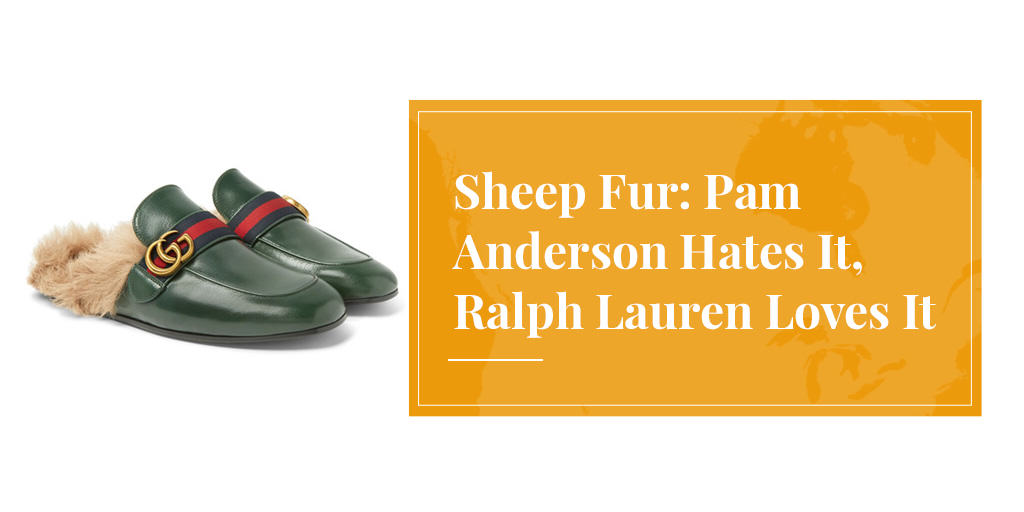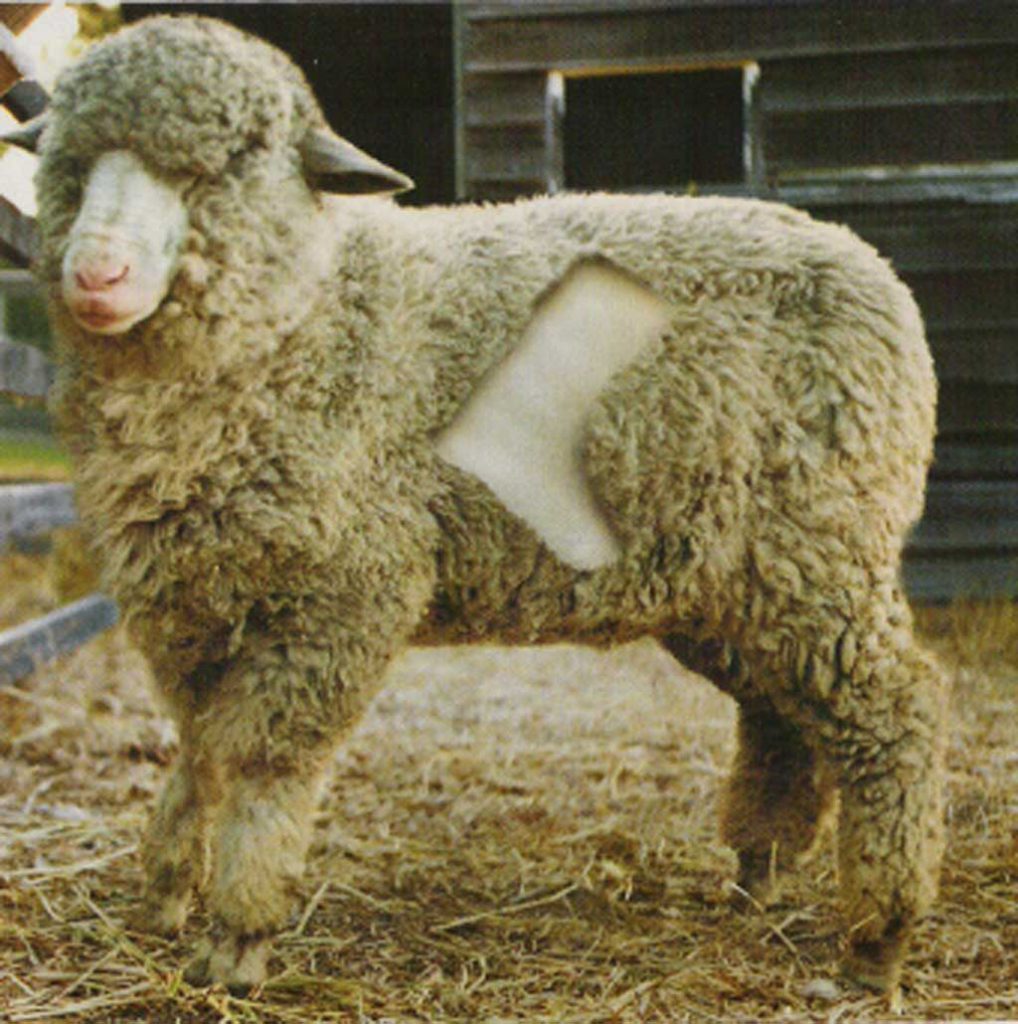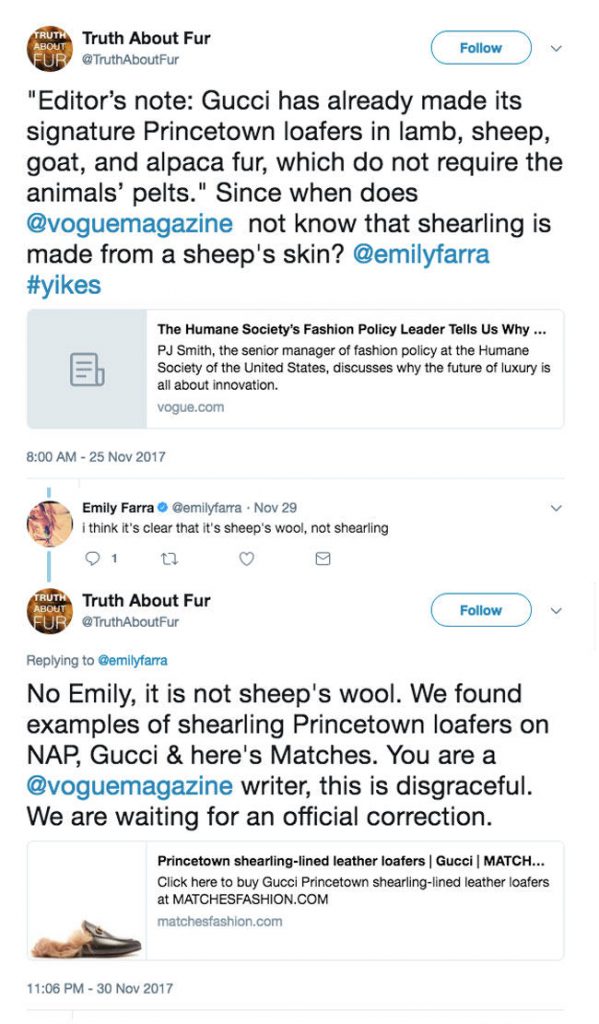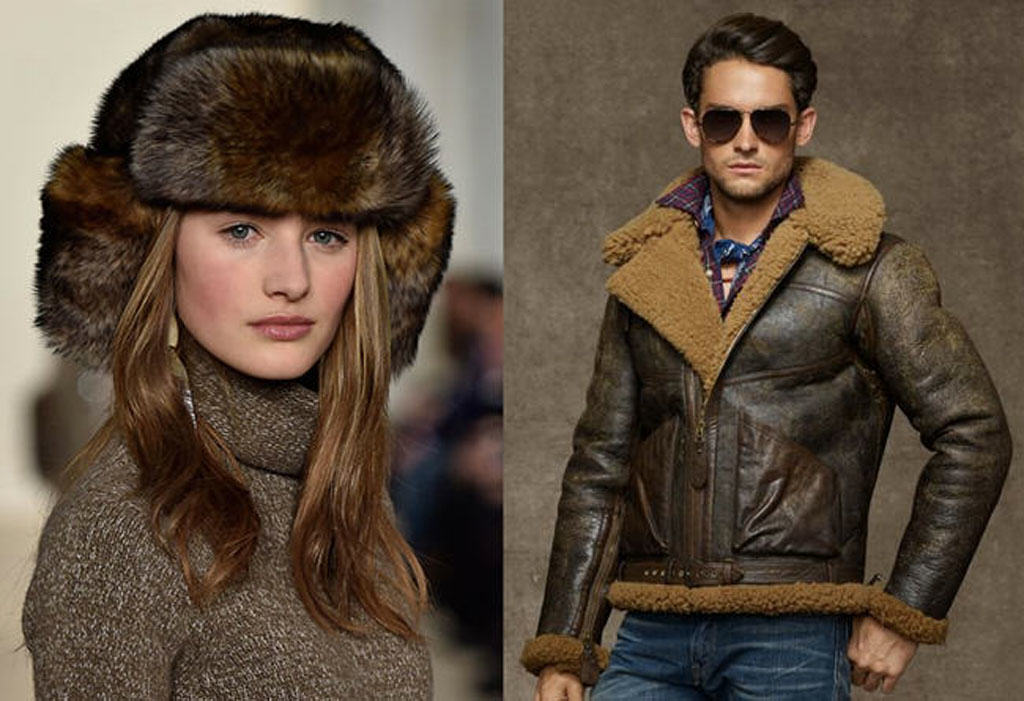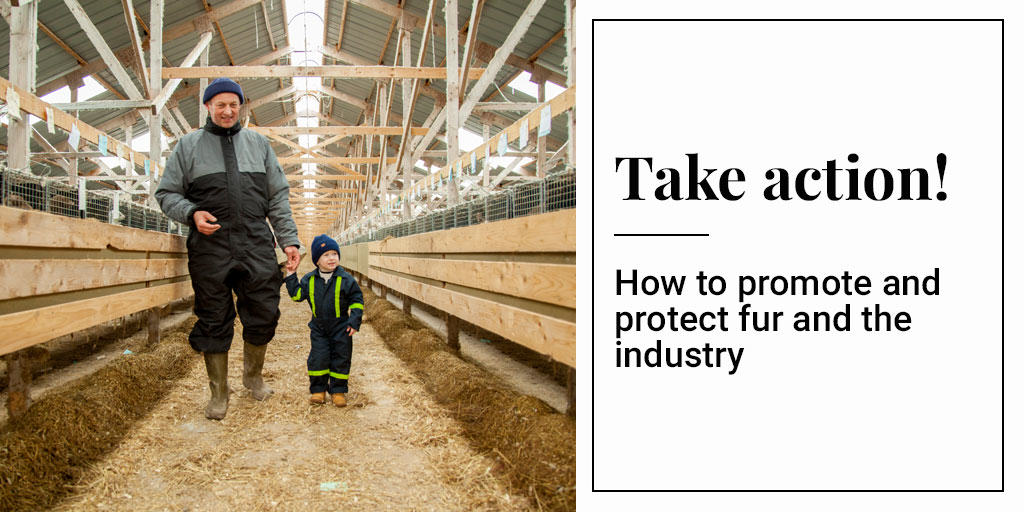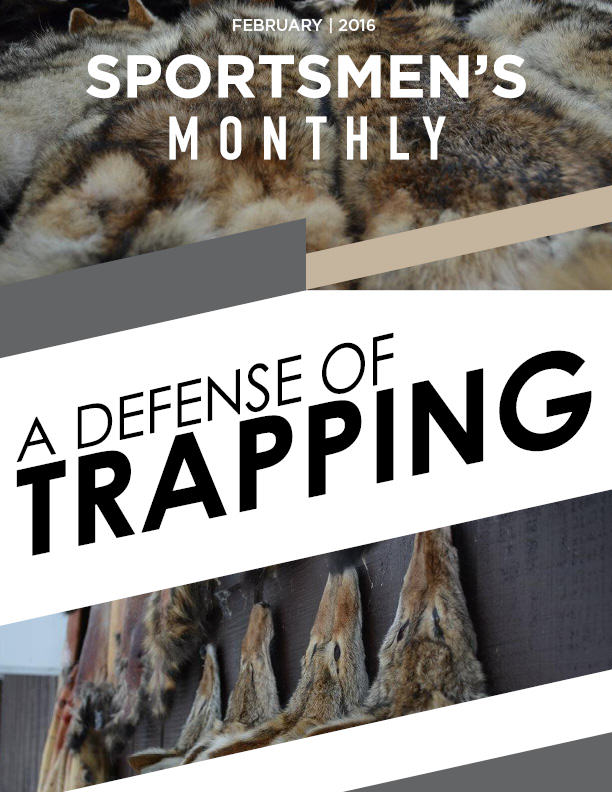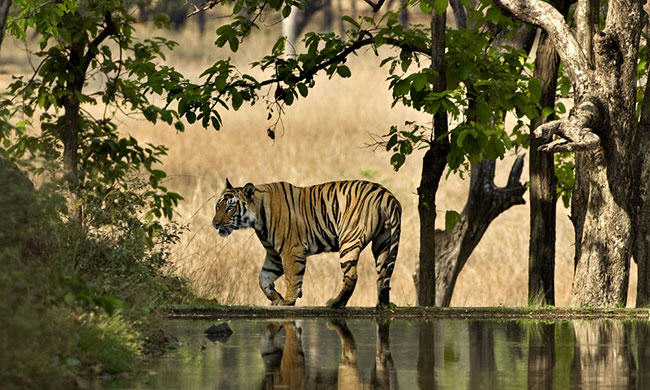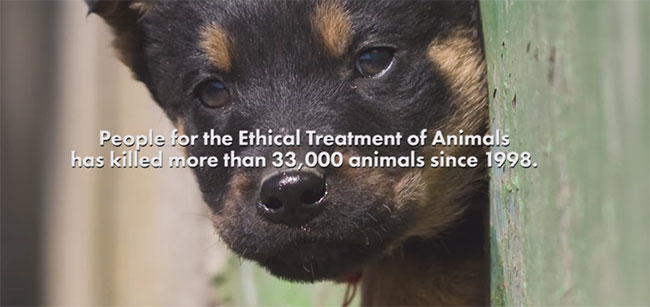Something that keeps writers like me employed is that no matter how good we are at spreading the truth, when…
Read More

Misinformation
Take Action! How to Promote and Protect Fur and the Industry
by Truth About Fur, voice of the North American fur tradeWhat are you doing to protect fur and the industry? The fur trade has faced many difficult challenges over the…
Read More
What are you doing to protect fur and the industry? The fur trade has faced many difficult challenges over the past few years. These include fast-changing lifestyles, new and cheaper (and usually synthetic) clothing materials, vertically-integrated companies, multi-national fashion-marketing giants ... and, of course, sensationalist animal-rights campaigns that spread disparaging and false information about our industry.
The fur trade has done a remarkable job of dealing with these challenges, especially considering its small-scale, decentralized and largely artisanal character. The increased use of fur in small pieces (vests, jackets), trim (on parkas) and accessories (hats, scarves, handbags) has made fur more accessible to more, and younger, people than ever before. We see more fur now on the catwalks and in the streets than we have for decades.
Nonetheless, we know we still have lots of work to do. Animal activists continue to spread misinformation that can confuse consumers. Their latest strategy is to pressure fashion and outerwear retailers to drop fur from their inventories. And such pressures can be very difficult for consumers and retailers to resist, especially if they are not sure whether the fur trade is responsibly managed.
The truth, like it or not, is that our industry is too small to expect our professional associations and breeder groups to solve these problems alone. We all have to pitch in to protect fur tradespeople and get our messages out to consumers, designers, retailers, media, politicians, and the general public.
Here are some ideas about things that YOU can do to help. And we’d love to hear some of the other things that YOU are doing to let people know about our remarkable, heritage industry.
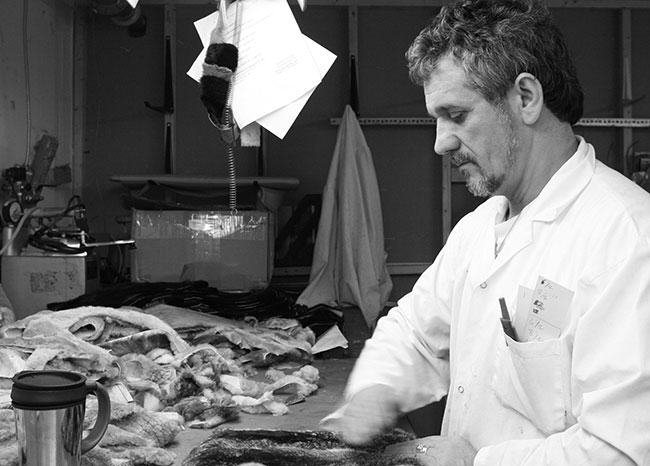
If you are a fur designer, manufacturer, wholesaler or retailer:
- Be active online. Comment on news articles and on social media, presenting polite and knowledgeable arguments to defend the trade. Even if people don’t comment back, people are reading. Let’s present ourselves as an industry that is confident about its processes.
- Answer customers' questions honestly, and if they press you about issues, respond accordingly. Have the information ready and know the facts. Our industry has often been misrepresented, so we need to be especially open with our customers.
- If you have a company website, add our link to your website so people can click through to get facts about the trade, and refer customers/associates/suppliers to TruthAboutFur.com
- Add the video The Fur Industry in 2 Minutes Flat to your website using this embedded link: <iframe width=“560" height="315" src="https://www.youtube.com/embed/sydmyD8ouxM" frameborder="0" allowfullscreen></iframe>
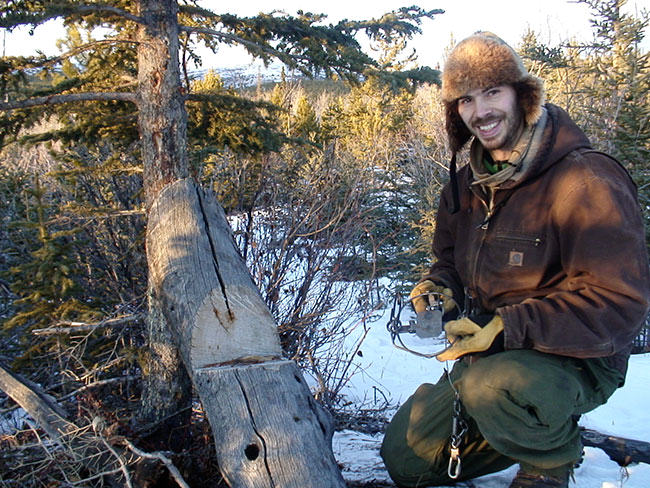
If you are a trapper:
- Take guests out on the trap line from time to time. It may slow you down, but it is worth it. Read more on taking people out on your trapline.
- Volunteer to hold classes and teach people about what trappers do.
- Educate the young. The key to sustaining this wonderful activity and to protecting fur trapping is to get young people interested in it.
- Be active online about what you do, how you do it, and why you do it. Trapping is very complex and it is important to understand the benefits trapping brings to wildlife populations and how licenses fund responsible conservation.
- Ally yourself with hunters and fishermen. Sportsmen need to work together to strengthen and protect their rights.
- For strong debate arguments, check out our Q&A section about trapping.
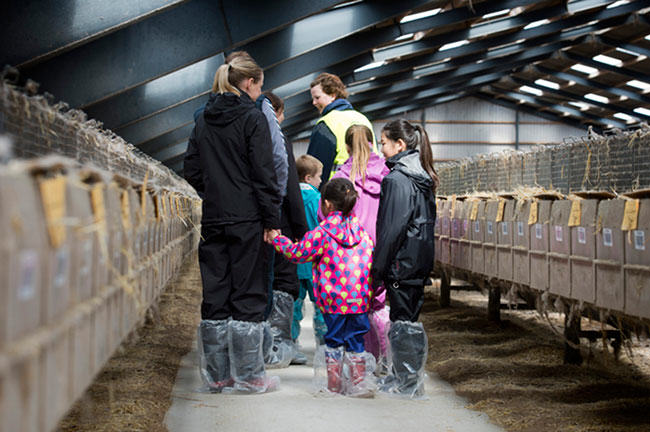
If you are a fur farmer:
- Open your farm up to visitors. Inviting people onto your farm gives you the chance to educate them on how the industry works, and show you have nothing to hide. Contact your local or national fur farming association (Canadian Mink Breeders Association or Fur Commission USA) for information on how to organize such an event.
- Answer questions. Fur farming should be easy to defend. Animals must be treated well in order to have nice fur, and even the activists can't deny this obvious fact. If people have questions about the animals’ pens, food, and health, be honest and tell them what you do and why you do it.
- Remind people that fur farms are an integral part of the human food chain, and that the animals eat leftovers from chicken farms and fisheries.
- Be active on online. Many farmers show photos of their animals and the daily life of farm work. Being open and transparent about your work is key to ensuring we protect fur farming and get people to support it.
- Ally yourself with other farmers and support the farming trade. Sticking together is key to protecting the farmers of North America.
- For strong debate arguments, check out our Q&A about fur farming on our website.

For everyone who supports or works in the fur trade:
- Be active online! Comment on articles and social media. Share the truth, dispel myths, and remind people that there are lots of us that support the trade.
- Work hard to debunk myths and share positive fur trade information on all of your personal networks.
- Check out the Truth About Fur website to brush up on the facts, and refer people to it if they have questions about the trade.
- Support brands who sell fur, and try to avoid brands who have an anti-fur stance.
- Buy fur! Whether you are buying new, vintage, a coat, or an accessory, one of the best ways to support and promote this remarkable heritage industry is to buy and wear fur products.
- Support real animal welfare and conservation, not “animal rights”! Make sure you know the true agendas of any charities you support. If you care about pets, always donate to your local shelter and not the national “animal-rights” groups such as PETA and HSUS. Read up on charitable donations.
- When you wear fur, tell people why you do it. Be vocal about your support of the trade and don’t shy away from expressing it.
Stay in touch! If there is an important issue we need to address quickly, contact us by email, Facebook, Twitter, or Instagram. Do you have an amazing story to share? We want to post it in our Truth About Fur blog. Help us be the go-to place to represent the true image of the industry. Send us your beautiful pictures. We welcome your comments and contributions.
Some of our useful resources include answers to the most frequently asked questions:
Sensationalized videos claiming to show “animal abuse” are sadly a fact of life these days for animal agriculture, and they’re often…
Read More
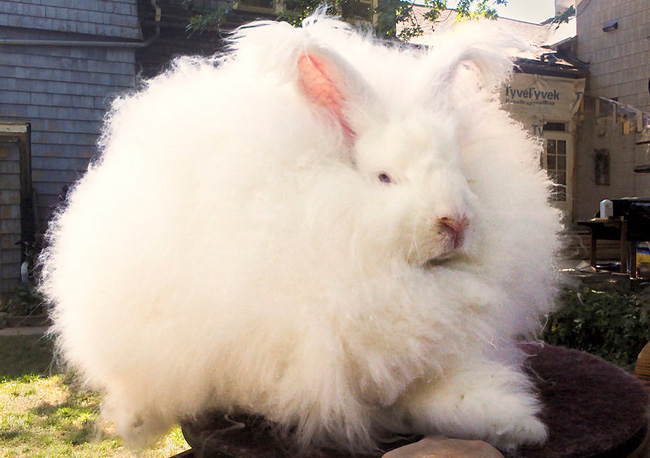
Sensationalized videos claiming to show “animal abuse” are sadly a fact of life these days for animal agriculture, and they’re often promoted (if not actually filmed) by People for the Ethical Treatment of Animals. One such video, dealing with wool production from Angora rabbits, premiered in 2013 and has gone unchallenged - until now. An Angora farmer in the US contacted us to raise some real concerns about this video, which we think are worth sharing.
Before dissecting the video, let's start with a backgrounder on Angora wool production.
There are two distinct types of Angora rabbit: those that moult, and those that don’t.
Those that moult have their wool plucked every three or four months, just before moulting begins. Plucking produces the best wool because most of the guard hairs are left behind, but it is time-consuming. Plucking leaves in place the incoming coat, although one breed, the French Angora, can be fed a depilatory which results in the exposure of bare skin. Here's a video showing how to pluck an Angora properly.
Angoras that don’t moult are sheared. Because the guard hairs are included, the wool is not such high quality, but collecting it is quicker and the yield is higher because wool can be sheared even from sensitive areas of the rabbit's body. Shearing is therefore more common in commercial operations. The most important commercial breed is the high-yielding and virtually mat-free German Angora. Ninety per cent of Angora wool production today is in China, and almost all Chinese farms raise German Angoras. Here's a video showing how to shear an Angora properly.
Show Time
OK, it's time to watch the main attraction. If you find videos of animal cruelty hard to stomach, just give it a miss and take my word.
0:10 – 1:03: This rabbit is almost certainly a non-moulting German Angora, even though it looks very similar to a moulting French Angora. We can tell it's a non-moulting breed because its legs are tethered to what is called a stretching board. These are sometimes used, but not always, when rabbits are sheared.
PETA describes the stretching process as follows: "During the cutting process, their front and back legs are tightly tethered – a terrifying experience for any prey animal – and the sharp cutting tools inevitably wound them as they struggle desperately to escape." In reality, while rabbits being stretched for the first time might be nervous, they soon learn to relax. Stretching keeps the rabbit still and pulls the skin taut, thereby preventing nicks and cuts from the shears - the total opposite of what PETA claims. Here's an excellent video demonstrating how stretching is done.
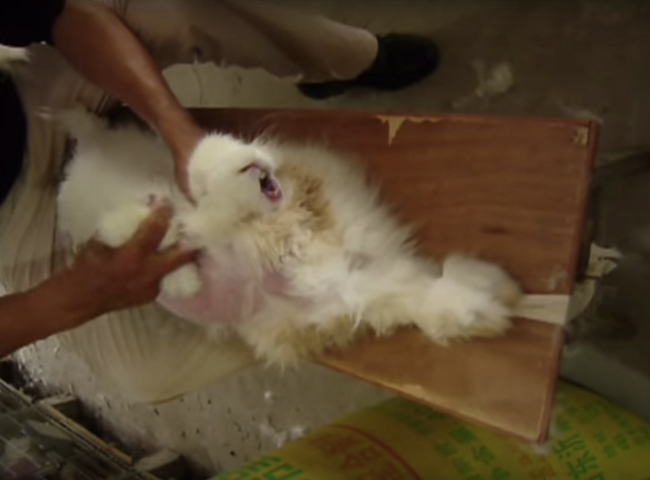
Oh, but what's happening now? Having set the rabbit up for shearing, the man is plucking it right down to its skin! He is also applying far greater force than is ever needed to pluck a moulting breed. This is all wrong for two reasons. First, the rabbit is obviously in pain. Second, as US Angora farmer and advisor on this blog post Dawn Panda says, this could be called "worst business practice". "We see the wool being yanked off, guard hairs included, in a manner that will ruin the coat for several cycles," says Dawn. "It will damage the hair follicles and greatly reduce the quality and value of future harvests as new coats will grow in coarser and hairier. No one trying to make money would do that."
This raises a disturbing question. Are we seeing a non-moulting German Angora being forcibly, and very roughly, plucked just for the camera?
READ ALSO: "Saving Society from Animal 'Snuff Films;". Fur Commission USA.
1:04 - 1:17: Here a rabbit is being sheared, so we don't see any pink skin. It appears calm. At this point in the video, it is not clear whether this footage and the footage of a rabbit being violently plucked were shot on the same farm. We'll come back to this because, if all the footage is from one farm, the question is raised why one rabbit would be plucked and one sheared.
1:18-1:22: Here a rabbit that has just been sheared is shown suspended in the air by its front legs. This makes no sense, Dawn assures us. There is no part of Angora husbandry in which a rabbit would ever find itself in this situation. It can't even be claimed the rabbit fell off its stretching board because it's far too high. Once again, we can’t help but wonder if this bizarre scene was staged for the camera.
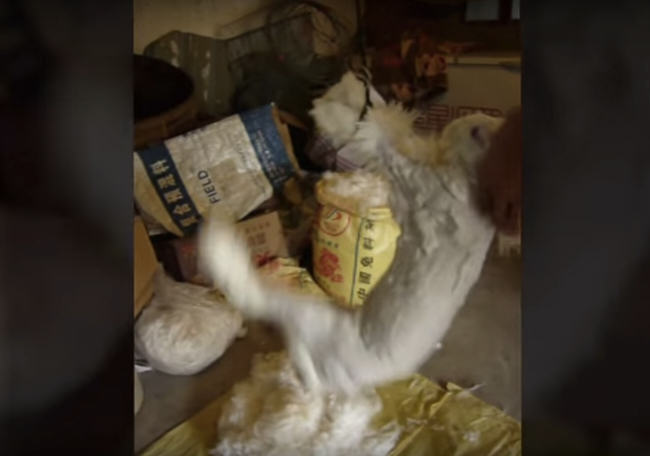
1:36-2:02: Here we see a parade of seven rabbits in their cages. Of these, the first three still have hair on their torsos and have been sheared. The next three have been plucked right down to their skin. The last rabbit cannot be seen clearly.
This scene suggests that the violent plucking at the beginning of the video and the shearing that followed took place on the same farm. And since commercial farmers generally don't have mixed herds of moulting and non-moulting rabbits, we can also suppose that all the rabbits shown are non-moulting German Angoras. The burning question is now unavoidable: Was the violent plucking of a non-moulting rabbit in the opening sequence staged for the camera? It would not be normal practice on a commercial Angora farm, insists Dawn.
"If animal lovers would use their heads, they wouldn’t be taken in by sensationalist publicity stunts," she says. "However, the addition of poignant music seems to ensure that one’s heart is going to overrule one’s head and voila! Misinformation is spread exponentially, the lie repeated until it’s accepted as fact. There are a number of excellent teaching videos on plucking and/or shearing Angora rabbits on YouTube; the lack of screaming, struggling or any pain is the norm, not the exception. This PETA video certainly does not reflect the reality of Angora farming as I know it!"
Postscript
If PETA's Angora rabbit video was indeed staged to misrepresent normal practice, we should not be surprised. This ignominious tactic by animal activists traces its roots all the way back to 1964, when the urban myth about seals being "skinned alive" began with a film that was later proven to have been staged.
While people have a right to believe that humans should not kill or use animals in any way, they lose all credibility when they manipulate images to attack the reputations of those they disagree with.
Will Red Paint Be Thrown on Me If I Wear Fur?
by Truth About Fur, voice of the North American fur tradeThere’s a common misconception that if you wear fur in public, you’ll get red paint or pig’s blood thrown on you. This is…
Read More
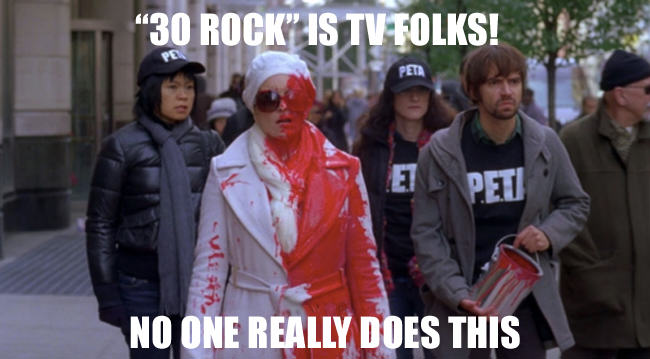
There's a common misconception that if you wear fur in public, you’ll get red paint or pig's blood thrown on you. This is an urban myth that's been around for decades, and we are here to reassure you that it will not happen! In fact we, and others, can’t find any evidence of this ever having happened to a regular person, and believe incidents involving celebrities can be counted on the fingers of, well, two fingers!
So prevalent was this myth in the 1980s and '90s that some North American furriers offered to clean their customers' furs for free if they were attacked with paint. But they never had to follow through on their pledge because it never happened. In fact, some animal activists even complained that the myth of attacks with red paint was invented by the fur trade to discredit them!
So, to answer the question, no, you will not get paint thrown on you if you wear fur. Here’s why.
- Animal rights activists don’t carry around buckets of paint or blood in the hope they will find someone to throw them on. It is massively inconvenient to have a bucket of paint in your bag, plus it might spill onto your vegan energy bar.
- Most people cannot distinguish fake fur from real. Not only does fake fur look very realistic these days, some of it even feels real. Would an animal rights activist risk attacking a fake fur wearer by throwing a bucket of paint on them? Not likely.
- It is illegal. Not only is it obviously illegal to throw paint on a stranger for any reason, if you throw it because you think that person is wearing real fur, in the US you could be classed as an animal rights terrorist. Only a fool would risk 10 years in a federal prison for throwing paint on someone who might not even be wearing real fur.
- It is counter-productive. Fur lovers are not easily cowed by animal rights activists, and if one of them has their fur ruined with paint, they will probably just replace it. And since fur coats are frequently insured, they won't even have to foot the bill. What is the point of destroying one fur coat, when it is only going to be replaced with another?
- Animal rights activists rarely commit crimes in public. They protest, shout, take their clothes off and are really annoying in public, but rarely commit crimes in public. Instead, they vandalise farms under the cover of night or sneakily film animals being “mistreated” for months before showing anyone the evidence. Or they threaten violence in the comments section of an article without revealing their real identity. Does this sound like the type of person who is brave enough to throw paint on a passerby in the middle of the street? No.
If you're concerned about other crimes that may be committed against you and your mink coat, consider this. Spitting on someone is a crime and leaves DNA. Plus CCTV cameras are everywhere. At worst, you might be at risk of having a post-it note stuck on your back, but even this childish prank happens very rarely.
So confident are we that wearing fur is safe, we set out to prove it! A few years back, one of our team wore visible fur pieces in public for 100 days over the winter. Mostly she was in Vancouver, Canada, a hotbed of anti-fur sentiment, but she also spent time in London, England, also reputed to be intolerant of fur. The result? Lots of compliments, not a single negative comment, and of course, no paint attacks. The experiment, called 100 Days of Fur, confirmed that fur is a very safe fashion choice.
Of course, animal rights activists do like their publicity, so celebs should be a more attractive target, right? But even then, our count currently stands at two: the late comedian Joan Rivers once got red paint thrown on her sable, and Vogue editor Anna Wintour once got hit with "fake blood". If you're a celebrity who's been sloshed with red paint, please tell us about it, and we're flattered you're reading our blog!
Sportsmen’s Alliance on Today’s Trapping Challenges
by Alexandra Suhner Isenberg, former Online Communications Director, Truth About FurThe Sportsmen’s Alliance is a US organisation that protects the outdoor heritage of hunting, fishing, trapping and shooting in all…
Read More
The Sportsmen’s Alliance is a US organisation that protects the outdoor heritage of hunting, fishing, trapping and shooting in all 50 states. Between fighting in the courts, political lobbying, and countering campaigns by animal activists, they are kept busy. We talked to Vice President Marketing and Communications Brian Lynn about trappers, hipsters and sound bytes.
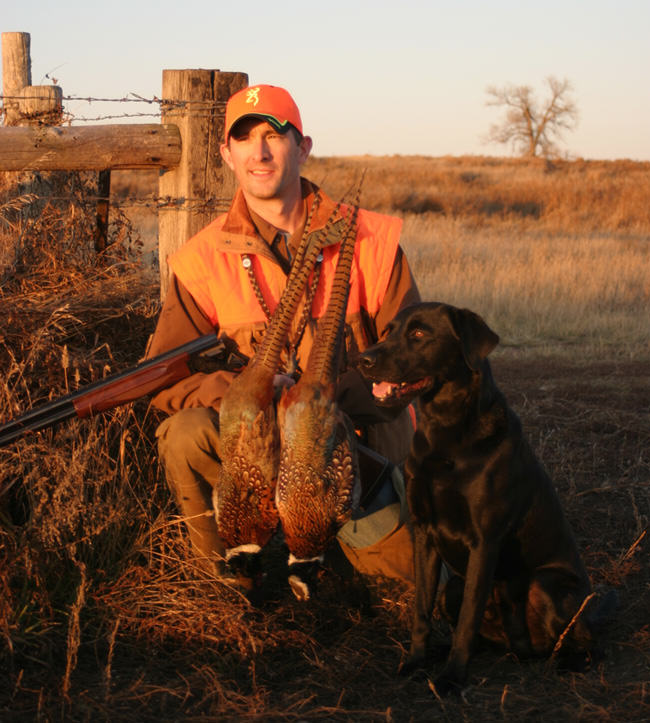
Alexandra: What percentage of your members are trappers versus hunters and fishermen?
Brian: I’d say somewhere between 10 and 20%. It’s not a huge number, but the trappers are the most active, passionate, and engaged audience there is.
Alexandra: Interesting you say that, because we think that too.
Brian: Trappers are the ones on the front lines. They are constantly under attack.
Alexandra: Are you referring to the amount of legislation that people are trying to put into place to try and ban trapping?
Brian: Yes. Animal rights organisations, legislation, the ballot box – trappers are constantly under attack. Whether it is changing the seasons, eliminating the seasons, or regulating traps, they are getting hammered left and right.
Alexandra: Do you think that trappers are getting attacked more because they are fewer in number? Or perhaps because in the US hunting is more associated with a weekend pastime?
Brian: It is both. There aren’t as many trappers, so it is more of a fringe endeavour. Also it lacks the idea of a sport – of you versus the animal. To the uninitiated, it just seems like you are going out there, putting some bait out, and whether a wolf, bobcat, bear, or your dog comes along, they get snapped up and killed cruelly. It looks barbaric, and it is a hard sell for us to protect. It is an easier sell to misrepresent. People already are ignorant about it; urban people are like, “You do what?” It is a harder thing to protect because of the ignorance, and it lacks the perception of sport and the “you versus the animal.”
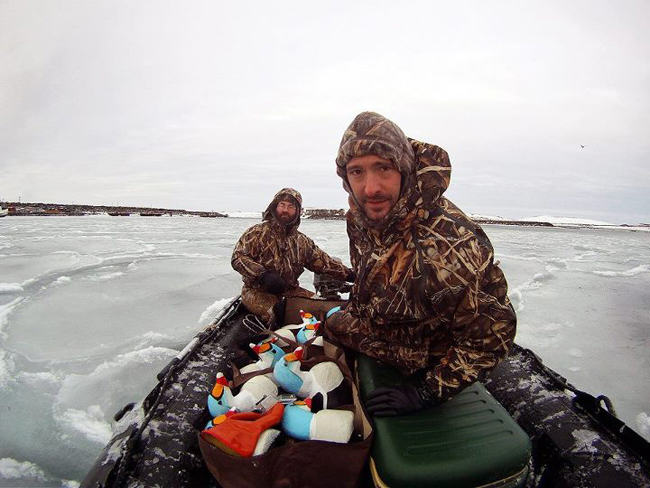
Active or Passive Management
Alexandra: It's interesting how urban folk don’t mind trapping when there’s a coyote eating their cats, or beavers flooding their home.
Brian: That’s the whole thing. People say, “This doesn’t seem fair, that doesn’t sound right,” until it impacts them. Once the deer come in and start eating their petunias, now they're mad. Or they're hitting deer with their car. Now they want something done. Don't kill the bears until the bears start eating your kids. It boils down to active management versus passive management.
We did a piece on defensive trapping a couple of months ago in our newsletter, and without trapping, state agencies will spend hundreds of millions of dollars on trapping nuisance animals and flooding. Nobody understands that until it happens. The animal rights activists try to couch it as, “We don't need to manage populations." They try to pass off the Disney idea that “nature will balance itself”, which never really happens. But even they are saying passive management is ok. When the mountain lion becomes overpopulated and one starts eating their cats, then it's ok for the state to come in and kill that one lion. Well, it costs a ton of money, and it's not fixing the problem. With active management, you are mitigating the booms and busts and managing them actively with hunting and trapping. The animal rights groups just want to let everything go wild, and passively manage it when it becomes an issue with humans, which is just not going to work because we see disease, starvation, plus human-wildlife conflicts.
Alexandra: What are some of the biggest issues that you are dealing with right now, and have the kinds of issues evolved much over the past 20 years?
Brian: They go in waves and trends. In the 1980s, animal rights groups went after bow hunting, in the ’90s they went for mountain lions and some bear-hunting tactics. Last year we saw a lot of dog-related activity: kenneling, breeding, selling legislation. A lot of it is aimed at puppy mills, but if enforced to the letter of the law, it will stop hound hunting, kenneling, or selling those dogs.
We also saw a lot of apex predator issues – black bears and wolves. And now we are seeing them setting the table to come back for more of what they attacked in the ’90s - black bears and mountain lions in the west, and the Great Lakes wolves.
They hit something hard, in multiple states, for a couple of years, then let it rest. They let the social consciousness of the non-hunters absorb it a bit, they’ve made it an issue. Then they let their fundraising base rest, then come back and hammer it again several years later. It makes for a better news story again. Then it seems like a big issue that keeps coming out so they can get more funding, and it psychologically resounds with the public. “Oh, this is an issue, we need to do something about this!”
Great Lakes Wolves, Maine Bears
Alexandra: What are some of the activities that you do to fight the activists, and which campaigns have been successful?
Brian: Right now we are the lead on the Great Lakes wolves lawsuit. It is the Humane Society of the United States vs. the Sportsmen’s Alliance, the Department of the Interior, and the State of Wisconsin. So that is one we have been fighting for several years, and that should be moving through the court system, and we are appealing the last decision that was made in December 2014.
One of our more successful campaigns was the Maine Bear Ballot issue in 2014. The HSUS decided to go after bear hunting in Maine and hired a California firm to collect signatures and force it onto the ballot. The HSUS just self-funded the whole thing. If that had been successful, it would have basically put an end to bear hunting in Maine. It would have removed the use of traps, bait, and hounds to hunt bears, and that is 93% of the harvest. We went in, organised the grass roots groups, bought air time, created the messaging, and we ended up beating them by 8 points. And there was a couple of lawsuits out of that, that we fought and were successful in. We were successful all the way around and have a good base set up to protect it again, should they come back, and they have stated they are coming back again to stop it.
The thought is that they will just go after hounds and traps, because few people use these, so most people don’t care. This is when we get into apathy within our own ranks. If HSUS removes 85% of its opposition and 85% of its opposition’s funding, those who remain make easier targets.
"Sticking Up for One Another"
Alexandra: Some graphics in your social media send a message about uniting hunters, fishermen and trappers. What is the thinking here?
Brian: We need to be sticking up for one another, despite method of take. Even if you don’t participate in trapping and you don’t use bait, we can’t stand around and say, “That’s doesn’t affect me.” Once hound hunting falls, once bait hunting falls, once trapping falls, they are coming after what you do want to do. We need to be united regardless of how we are participating in these activities.
Alexandra: What percentage of Americans do you believe support hunting, trapping and fishing, and how many are opposed?
Brian: Hunters and anti-hunters are about the same size, 5-10% of the population. And all of the polls show that 75-80% of the general public support hunting as a management tool. That’s great. But the problem is that all that support goes right out the window as soon as emotion gets into it. People's minds are changed really quickly if they are shown an animal flopping around in a trap or a dead trophy shot. We move from the logical “That makes sense, I support hunting,” to the emotional “Oh, but I don't support it in this instance. It seems cruel.”
The other side can just throw words around like “slaughter” and sway those non-hunting voters.
Our biggest challenge is telling our story, why we have to do it, why it makes things better, the funding of conservation, managing populations, habitat, carrying capacity of the land. That’s a long story which can be boring if you aren’t into it, and if there is legislation or a ballot initiative, and a news anchor puts a microphone in your face and you try and explain carrying capacity of the land and funding of conservation, it is long, boring, and not sound-byte stuff. Then they ask the other side why we need to stop it and they say, “It's cruel, they are slaughtering animals with babies.” There’s your sound byte.
"Hipster Deal Big Move Forward"
Alexandra: Have the demographics of your supporters and members changed? There is a hipster trend now, with people doing things themselves, growing their own food and maybe hunting. They were traditionally more on the left of the political spectrum, whereas hunters tend to be on the conservative side. Do you see this new demographic supporting outdoor activities?
Brian: We are seeing a bit of a bump, which is great from a branding and messaging perspective. This is important for the hunting and trapping industry in general, but here at the Sportsmen’s Alliance we are very engaged, political, more hardcore. The new people coming in are a more holistic type of person, who may not be political.
For the broader industry, though, the whole hipster deal has been good. From the perspective of acceptance within the mainstream, those people are sharing with other people, within city life. It is about taking responsibility for their food, and them relaying their message in a way that their friends can understand. That’s where I see it as being the biggest move forward for the industry. How do you reach someone in LA? We aren't going to reach some hipster in LA, but some guy at an LA party who went out, harvested his own food and killed a deer, that is going to do more good than anything we are doing as an industry to disseminate the proper message.
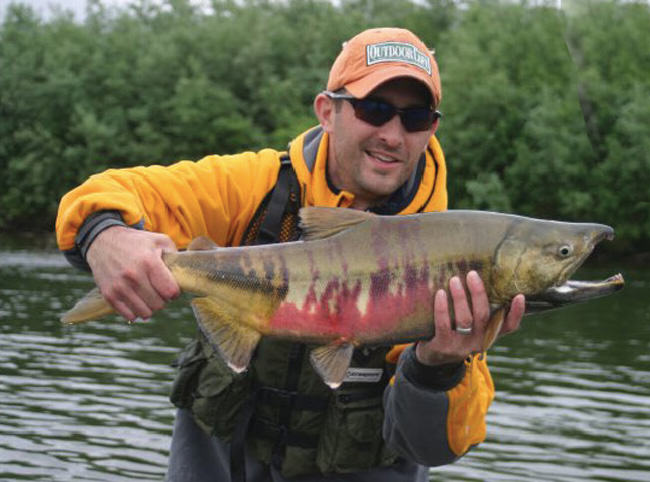
Alexandra: Do you cooperate with a Canadian counterpart?
Brian: There is some run-over, but nothing official. In Maine, we are involved in two lawsuits on trapping Canadian lynx. In Maine, Canadian lynx are on the Endangered Species List, but north of the border they are not.
There are incidental take permits, and a certain number of Canadian lynx can be caught in traps without the trapper or the state being in violation of the Endangered Species Act. The HSUS is trying to stop that; they are trying to get the incidental take permits revoked. If they succeed, that would mean that anywhere there is an endangered species of any kind, trapping can be stopped. If you take it a step further, anywhere there is an endangered fish in a river, you could apply the same logic. You can’t fully control what steps into a trap, therefore you can’t trap anywhere there is an endangered species, just like you can’t always control what is going to bite your hook, therefore no one can fish anywhere there is an endangered fish. So that’s a lawsuit we are involved in in Maine.
"Educate Those Not Within Your Group"
Alexandra: Is there any advice you have for trappers about protecting their rights, proactively?
Brian: They need to educate non-trappers about what they do: about how trapping is regulated, how hard it is, what you do to prevent non-target by-catch. People need to understand that, and it is not the people that are already in your social groups, it needs to be the non-trapper or the hunter that doesn’t understand it, so you can help eliminate that issue of hunters not caring. For example, there are a lot of bird dog hunters that hate trapping because traps will be out during grouse season and they are worried their dogs might get snagged up in them. We need to try and educate those people. It is all about educating those not within your group.
As for state and provincial organisations, they need to start collecting funds and putting these aside. This is something we are saying in Maine, start a war chest, because the attack is coming, it is just a matter of time. The HSUS is so rich they can self-fund any campaign they want to. They are a $130-150 million a year organisation, so they can just decide “this is where we are going to go, and we will spend $3 million.” If HSUS comes and you sit there fundraising for the first six months, that's a six-month head start they have in swaying public opinion. If you can hit the ground running, and you already have a war chest, you are better off. That’s hard for groups to do, though, because unless there is a bogeyman right there, those funds start to look very attractive to dip into and use for other things.
Alexandra: Thank you for taking the time to speak to us!
For further reading, check out this great Sportsmen's Alliance content:
The Anti-Hunter’s Playbook
A Defense of Trapping (full issue)
A Defense of Trapping (article)
Why All Sportsmen Need to Defend Trapping
Introducing Youth to Trapping
And connect with them on their website, Facebook page, Twitter, and Youtube.
Fashion house Giorgio Armani announced this March it will no longer be using any fur in its products because, in the…
Read More
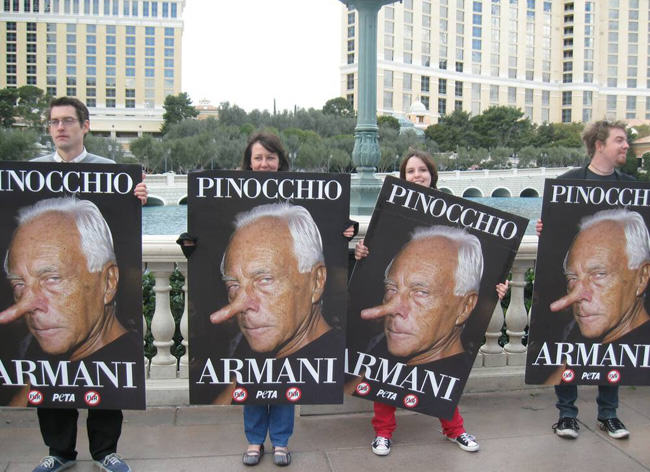
Fashion house Giorgio Armani announced this March it will no longer be using any fur in its products because, in the words of its patriarch and namesake, “Technological progress … allows us to have valid alternatives at our disposition that render the use of cruel practices unnecessary as regards animals.” While this tortuous explanation may sound sincere, it’s not. It’s PR bunkum. So why is Giorgio Armani really ditching fur?
OK, first I need to explain why Giorgio Armani's statement is bunkum - and add a general disclaimer that I don't actually know what went down here!
Giorgio Armani's statement is bunkum because he almost certainly never said it, or even thought it, or had a hand in picking the words. It's just part of a script prepared by his animal rights handlers.
How can I be so sure? Let’s start with some context.
• Fashion designers don't use fur for years and then quit of their own volition. There's always pressure involved from animal rightists.
• Like all fashion houses that use fur, Giorgio Armani has been harassed by animal rightists for years, but unlike some, has shown stiff resistance. Even now, its commitment to quit fur may not mean anything. In 2007, Giorgio told the press, "I spoke with the people from PETA and they showed me some materials that convinced me not to use fur." But a year later he was back with a collection of fur coats for babies! PETA responded with a poster campaign of Giorgio with a Pinocchio nose and has been gunning for him ever since.
• Giorgio Armani is a huge name in everything from ready-to-wear to haute couture, but in the world of fur is barely a player anymore. For the past several years, rabbit trim has been its thing. So quitting fur will hardly impact its collections. Add to this the fact that two major markets that have buoyed fur's revival this century are now in the doldrums (Russia) or slowing down (China), and we can say that quitting fur will have a negligible impact on Armani's profits.
Make This Problem Go Away
Against this backdrop, we can perhaps understand the real reason Giorgio Armani is ditching fur.
As Keith Kaplan of the Fur Information Council of America explained to WWD, when designers are harassed by animal rightists, "I think they consider whether it is worth the threat of store protests and disruption of business and so forth. Right now, because of the economic conditions in Russia and China, I think designers are evaluating and saying, 'Perhaps at this juncture, it might not be. We’ll give in at this point to make this problem go away'."
And that, in a nutshell, is probably it. Giorgio Armani just wants to get the animal rights lobby of its back, at a time when the business is already tough enough.
The deal would follow what is now a standard template. The animal rights groups pen a statement to be issued in the name of the designer, claiming he has "seen the light" and will be going fur-free. The animal rightists then trumpet victory, claim full credit for their powers of persuasion, and promise to stop picketing stores and generally making the designer's life miserable.
In the case of Giorgio Armani, its decision to cave was announced by HSUS and the Fur Free Alliance, “a coalition of 40 animal protection organizations in 28 countries that are trying to end the fur trade”. “Pursuing the positive process undertaken long ago,” Giorgio's prepared script said, “my company is now taking a major step ahead, reflecting our attention to the critical issues of protecting and caring for the environment and animals.”
Had Giorgio spoken his mind, he might have said, "After years of relentless pressure, I have decided to throw in the towel and give the animal rights nuts what they want because they're a pain in the butt and I just want them to go away!”
100% Fur-Free?
Meanwhile, inquiring minds are still asking two questions: Is the "100% fur-free" clause in effect? And was any hidden pressure brought to bear on Giorgio Armani?
The "100% fur-free" clause is an unspoken compromise between animal rightists and designers used in closing a tough negotiation. In essence, it is agreed that the animal rightists will praise the designer for abandoning fur completely - going 100% fur-free. Meanwhile, the designer quietly continues to use fur that is a by-product of food production.
Luxury goods manufacturer Hugo Boss recently reached such a deal. In its 2014 Sustainability Report, it explained that it had been "in dialog with several animal and consumer protection organizations for many years, for example with People for the Ethical Treatment of Animals." Presumably because of these "many years" of harassment (sorry, dialog), it announced that from 2016, it would be restricting the sources used for its fur supplies. Specifically, it would be "concentrating on furs that are byproducts of the food industry," while halting use of pelts from "raccoon dogs, foxes or rex rabbits". No mention was made of quitting fur, or even of reducing overall fur use.
HSUS and the Fur Free Alliance then announced that Boss was going "100 percent fur-free", a false claim that has been repeated widely, including in WWD.
SEE ALSO: IS NO FUR THE RIGHT MOVE FOR HUGO BOSS?
You might think Hugo Boss will get hauled over the coals the next time it trots out a collection of shearling (sheep fur), but it won't. Ralph Lauren, which uses an enormous amount of shearling, proves that.
FAST FACT: What is shearling? We all know that sheared beaver is the hide and hair of beaver that has been sheared to a short pile to make it lighter and less bulky, and give it a plush feel. Sheared mink is the same deal. When the hide and hair of sheep are used, it is known as shearling. All are types of FUR.
Ralph Lauren's deal with PETA, on the face of it at least, is the most shameless piece of self-serving, mutual ass-kissing in the history of the fur trade's relationship with animal rightists. A footnote in the show notes for Ralph Lauren's fall 2015 collection says it all: "Ralph Lauren has a long-standing commitment to not use fur products in our apparel and accessories. All fur-like pieces featured in the collection are constructed of shearling."
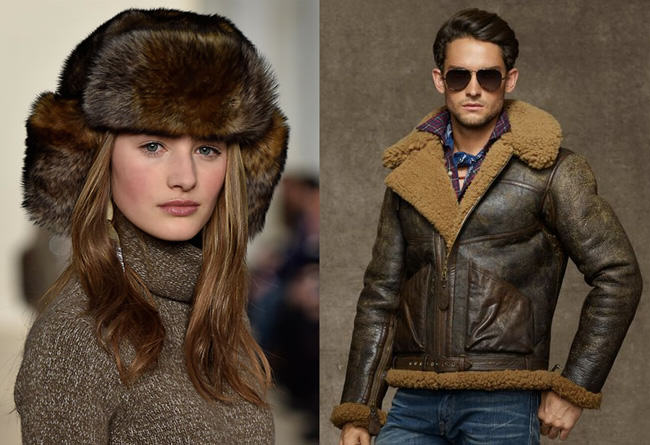
So Ralph Lauren is now "100% fur-free", and proudly compliant with "PETA guidelines" since 2006. And PETA loves Ralph Lauren right back. All Ralph Lauren has to do is stick to shearling (tons of it), while both parties insult our intelligence by pretending shearling is not fur.
Hidden Pressure?
Last but not least, we inevitably ask ourselves whether animal rightists finally found Giorgio's Achilles' heel. It's a reasonable question when we consider how long he held out. Maybe he really did fold because fur is not important to the company, or because the luxury fur market is slowing. Or maybe he was made an offer he couldn't refuse!
Yes, it's pure speculation, but that was the buzz when Hugo Boss made its deal. No one put it in print, or spoke it on the air waves, but people were thinking it. Could Hugo Boss have been threatened with a campaign telling the world how it got its big break?

Hugo Ferdinand Boss: Nazi Party member, sponsoring member of the SS, and admirer of Hitler. It's not much of a résumé, is it? This is the man whose company took off as an official supplier of uniforms to branches of the Nazi Party, including the Brownshirts, the SS and the Hitler Youth, using POW’s and forced labourers.
Animal rights groups know all this stuff, of course, and probably have a bunch of other cards up their sleeves just waiting to be played. And maybe they had the dirt on Armani too - we'll never know.
But one thing is for sure: Giorgio Armani did not quit fur because "Technological progress … allows us to have valid alternatives at our disposition that render the use of cruel practices unnecessary as regards animals"! As readers of Truth About Fur know, and hopefully Giorgio Armani too, technological progress – and a strong commitment by the industry – now allow us to produce beautiful furs without animal suffering.
5 Reasons Why PETA Won’t Make Me Ditch My Canada Goose
by Alan Herscovici, Senior Researcher, Truth About FurIt is minus 23 degrees Celsius (-32C with the wind-chill) but I am snug as a bug in my Canada…
Read More
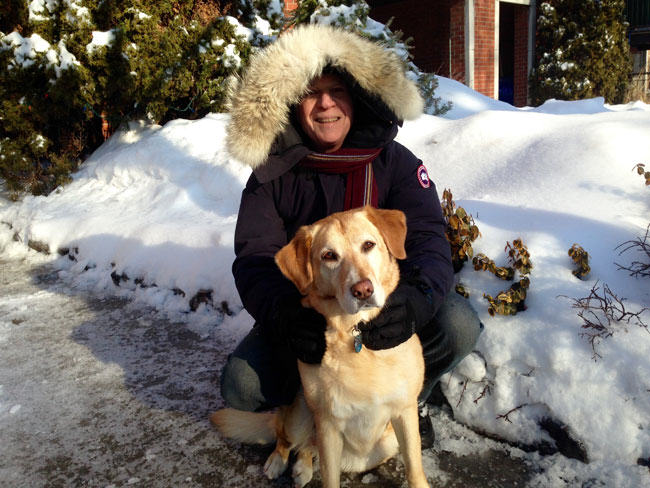
It is minus 23 degrees Celsius (-32C with the wind-chill) but I am snug as a bug in my Canada Goose parka as I walk Maggie, our 9-year-old Labrador Retriever.
It is so cold in Montreal this Valentine’s Day weekend that I cinch my parka hood completely closed, the soft coyote fur ruff forming a cozy, protective ring around my face. The goose down stuffing keeps the rest of me warm. I wonder how our animal activist friends are enjoying the bitterly cold weather, because this is the weekend they have chosen for their National Anti-Fur Day (“Have A Heart, Don’t Wear Fur”) protests in Montreal and other cities across North America.
As a sign of the times, Canada Goose parkas are the target of choice for this year’s anti-fur rituals. Why? Because even though fewer traditional full-fur coats are being worn these days, fur is now omnipresent in smaller items, accessories and trimmings. This has made fur much more affordable, and it is now being worn by more – and younger – people than we have seen in decades. It has been democratized.
SEE ALSO: Why fur trim keeps us warm.
In response, PETA has unleashed a new campaign “juxtaposing Canada Goose’s coyote-fur jackets with a disturbing video of a trapped coyote suffering after being shot.” The video is prefaced with a “warning” that it contains upsetting images, but this has apparently not discouraged many of PETA's fans because, it claims, the video “has received more than 16 million views.”
To drive home PETA's message, volunteers “wearing nothing but body paint and faux-fur ears and tails” would be posing “in bloody leg-hold traps” outside retailers selling Canada Goose parkas over the weekend. According to PETA Senior Vice President Lisa Lange, “Anyone who buys or sells one of Canada Goose’s fur-and-feather jackets is responsible for these animals’ terrifying and painful deaths.”
So has PETA’s “shocking” video convinced me to give up my Canada Goose? Not a chance, and here's why:
1. Video Shows Perfect Kill
The first problem is that PETA’s campaign video does not show a coyote “suffering after being shot”. Quite the contrary, we see the animal killed instantly with a direct shot to the head – exactly how it is supposed to be done. This is the most humane way to euthanize animals taken in restraining traps, as taught in trapper training manuals and mandated by the Agreement on International Humane Trapping Standards (AIHTS).
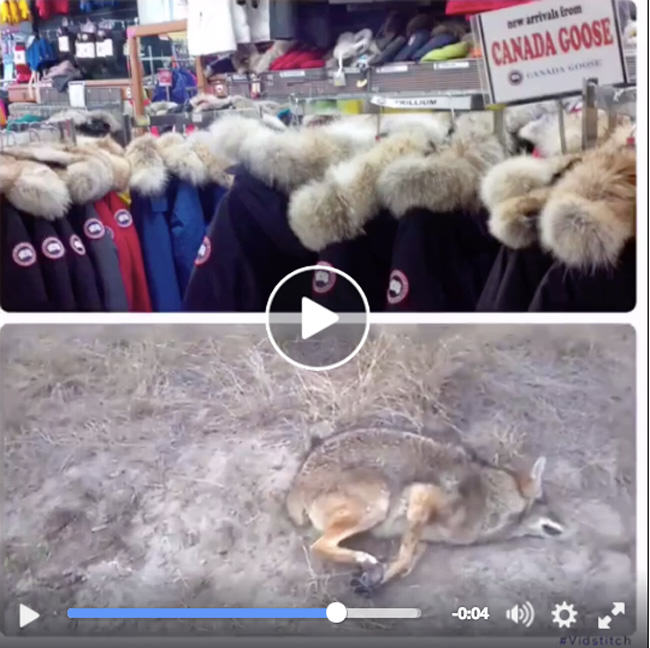
This is also the method proposed by the Canadian Council on Animal Care (CCAC) guidelines.
”3. Physical Methods: These techniques, when properly applied, kill rapidly and cause minimal stress. They may offer a practical solution for field euthanasia of various sized animals and prevent pharmaceuticals from entering the food chain ...
... Gunshot: While a shot to the brain of an animal produces a quick and humane death (Longair et al., 1991), it is best attempted when the animal is immobilized by injury or physical restraint.”
In other words, despite PETA's sensationalist warning – intended to shock people who have never seen an animal killed – its own video confirms that approved and humane methods are being used to euthanize coyotes.
2. Coyote Mums Not "Desperate"
PETA claims that “trapped coyote mothers desperate to get back to their starving pups have been known to attempt to chew off their own limbs to escape.” While this may have happened very occasionally with some species (e.g., muskrats) with older trapping systems, it never happens with modern foot-hold traps.
Furthermore, the whole "starving pups" scenario never happens with fur trapping for one simple reason: like other furbearers, coyotes are hunted for their fur in the fall and winter because that's when their fur is prime. At this time of year, their young are no longer dependent on them.
3. Coyote Predator Problem
As important as the nonsense PETA does say is what it doesn't say: It omits to inform us that coyotes have expanded their range across North America and are now so abundant that they are the number one predator problem for ranchers, preying on new-born calves and lambs. It also fails to mention the increasingly frequent reports, from Toronto to Los Angeles, of coyotes carrying away pet dogs and cats.
Several states and provinces have even offered bounties to reduce over-populated coyotes.
SEE ALSO: Will urban coyotes change the animal rights debate?
Culling must be carried out both to protect livestock and pets, and also the health of coyote populations themselves. Given that coyote populations must be managed, it is surely more respectful, and responsible, to use their fur for clothing than to throw it away.
SEE ALSO: Is it ethical to produce, buy or wear fur?
4. New Foot-Hold Traps Designed to Prevent Injuries
The foot-hold traps used to capture coyotes (as shown in PETA’s video) are not the diabolical, steel-toothed devices that activists love to hate. Their use was banned decades ago in North America.
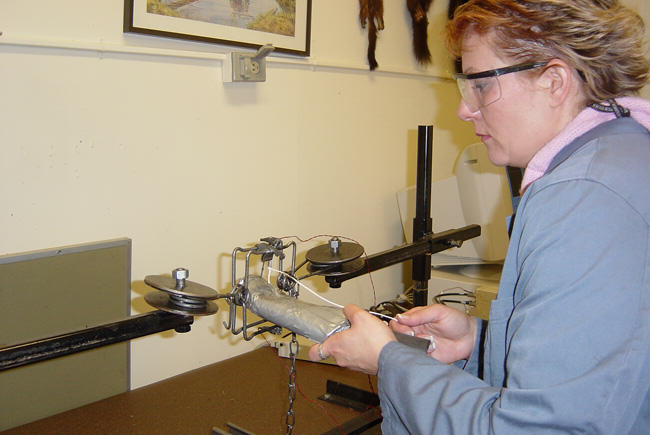
The new live-holding (“restraining”) traps have rubber-laminated, “off-set” jaws that do not close completely. Springs and swivels on the anchoring chain and other features have also been added to prevent injuries. In fact, these new “soft-catch” traps are commonly used by wildlife biologists to capture wolves, lynx and other furbearers for radio collaring or relocation/release into areas where they were once extirpated. Clearly they could not be used in this way if they injured animals as activists claim.
SEE ALSO: Types of traps.
5. PETA Opposes All Animal Use
Most importantly, PETA’s claims about fur are not credible because PETA is not looking for more humane ways to capture or kill animals we use. PETA opposes any use of animals, even for food or vital medical research.
PETA would have us all wear synthetic materials, most of which are derived from petroleum, a non-renewable resource. This is fundamentally anti-ecological. The modern fur trade, by contrast, is an excellent example of the sustainable use of renewable (and biodegradable) natural resources, a key ecological principle that is now promoted by all serious conservation authorities.
SEE ALSO: Fur is a sustainable natural resource.
A sixth, “bonus” point is a bit more philosophical. No one is obliged to wear fur (or leather or silk or down), but many of us appreciate the warmth and beauty of high-quality natural materials. The coyote fur and goose down in my Canada Goose coat also remind me that everything we depend upon for our survival still comes, ultimately, from nature. Thus the importance of protecting natural ecosystems for future generations.
***
UPDATE: Animal activists lodged a complaint with the Competition Bureau (the Canadian federal regulator) accusing Canada Goose of “false advertising” for claiming on its website that its furs are collected by licensed trappers using humane methods. We are pleased to report that this complaint was rejected by the Competition Bureau. See: Competition Bureau drops inquiry into false advertising claim against Canada Goose, by Christina Stevens, Global News, Mar. 10, 2016.
COMMENTS: Comments are now closed for this post.
5 Reasons Why It’s Ridiculous to Claim Animals are Skinned Alive
by Truth About Fur, voice of the North American fur tradeOne of the most insulting and insidious lies spread by animal activists is that animals are “skinned alive” for their…
Read More
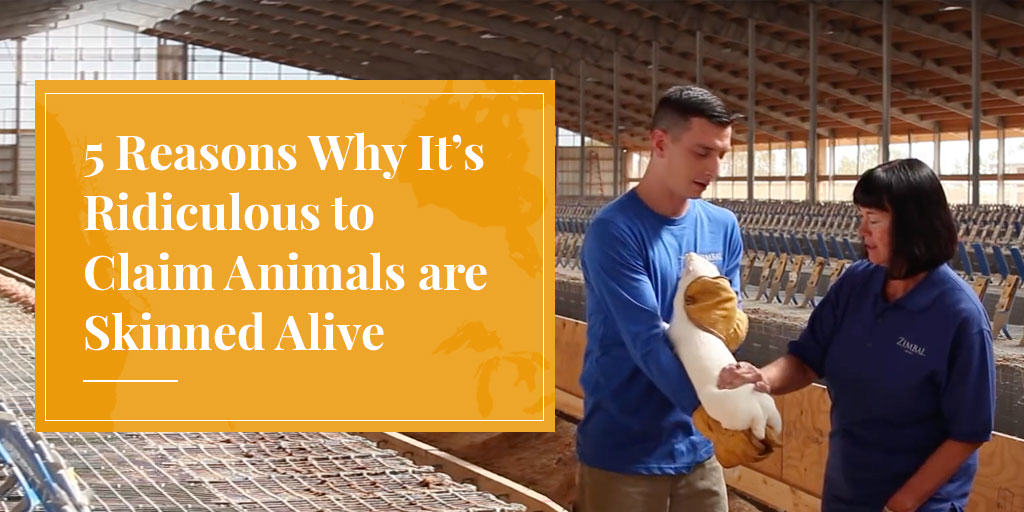
One of the most insulting and insidious lies spread by animal activists is that animals are “skinned alive” for their fur. The origins of this vicious lie go back fully 50 years, to the first seal-hunt protests, and those charges were soon proved to be false, as we will explain soon.
Ten years ago, the old myth was revived – this time about Asiatic raccoons. Since then, activists have become more and more extravagant, claiming (and, no doubt, believing) that rabbits, mink and other species are also treated cruelly, including being skinned alive.
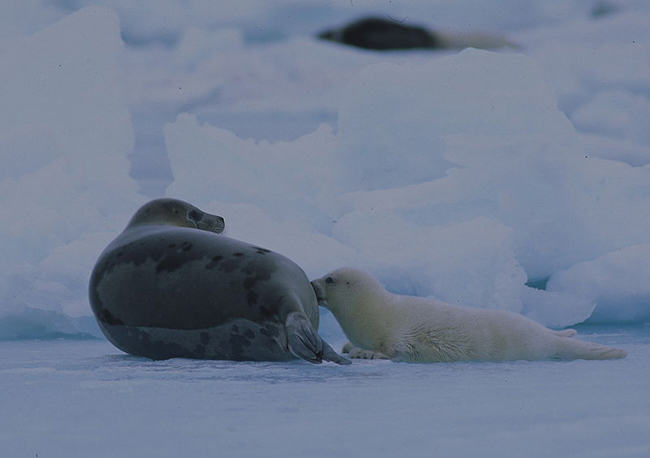
One of the main goals of Truth About Fur is to debunk falsehoods about the fur industry, so let's make something perfectly clear: Animals are NOT skinned alive for their fur. Period.
Here are some of the reasons why it is absolutely ridiculous to even suggest it.
1. It would be completely inhumane
Contrary to what activists would have us believe, most farmers take great pride in what they do; they take good care of their animals and treat them with respect. After all, their livelihoods depend on these animals, and the only way to produce the high quality of mink and fox for which North America is known is by providing them with excellent nutrition and care. When you work hard to care for animals – seven days a week, 52 weeks a year – you certainly don’t want to see them suffer.
It is therefore completely ignorant (and insulting) to claim that farmers would treat their animals with cruelty. They certainly would never skin an animal alive!
SEE ALSO: Is PETA's Angora rabbit video staged?
2. It would be dangerous for the operator
If respect for the animals and normal compassion were not enough to ensure that animals are not skinned alive, the farmer's self-interest would be. A live and conscious animal will move, putting the farmer at risk of being bitten or scratched or cut with his own knife – creating a real risk of infection or disease transmission.
Why would anyone expose themselves to such risks by skinning a live animal? The answer, of course, is that they don't!
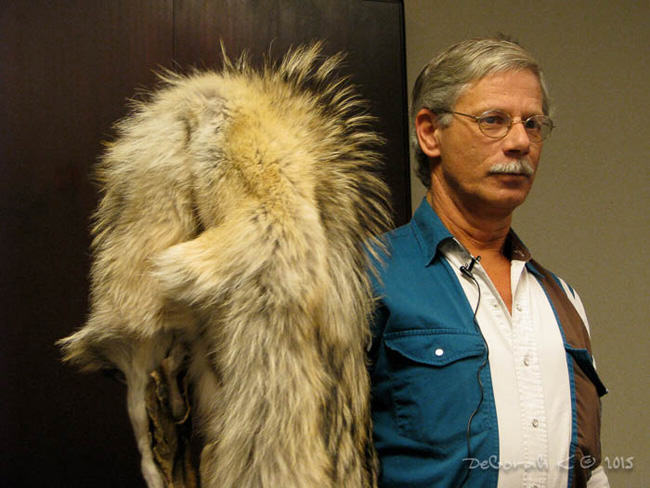
3. It would take longer and be less efficient
We've already explained the dangers of skinning a live animal – only common sense when you think about it – but let's also take a moment to consider how difficult it would be.
Farming is a business and, like in most businesses, it is important to be efficient. Clearly it must be faster to skin an animal after it's been euthanized. It is also important to understand that the skinning of a mink or other fur animal must be done very carefully, to avoid nicks and other damage that would lower the value of the fur.
So, again, why would anyone skin a live animal? Quite apart from the cruelty, it would make no business sense whatsoever.
4. It would spoil the fur
While activists like to accuse farmers of being greedy ("killing animals for profit!"), they don't seem to understand that skinning animals alive would work against the farmer's financial interest.
Today’s international markets are very competitive. The amount you earn for your fur is determined by a number of factors including pelt size, fur quality, colour ... and damage. But the heart of a live animal would be beating and pumping blood; attempting to skin a live animal would therefore unnecessarily stain the fur. Yet another reason why animals are not skinned alive.
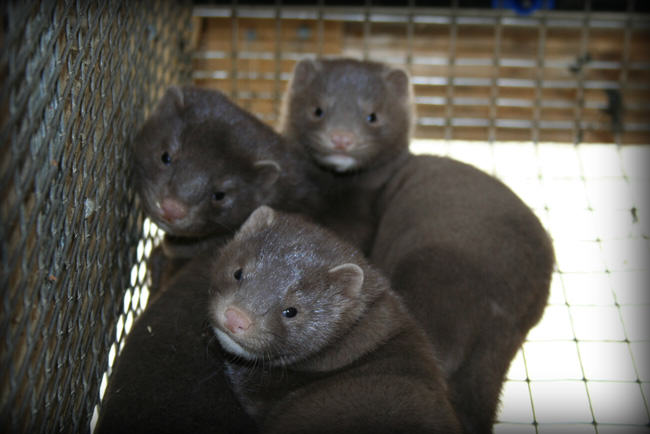
5. It's illegal
In North America, Europe, and most other regions it is illegal to cause unnecessary suffering to an animal. Skinning an animal alive is therefore not only inhumane and immoral – it's clearly illegal. Yet another reason why animals are not skinned alive.
But what about that video?
Activists frequently cite a horrific video taken in a village somewhere in China as "proof" that animals are skinned alive in the fur industry. When this video was first shown, in 2005, fur industry officials contacted the European animal-protection group that released it. They asked for a complete, uncut version of the video, as well as for information about when and where it was filmed, so a proper investigation could be conducted.
Unfortunately, the activists refused to provide this information. Strange.
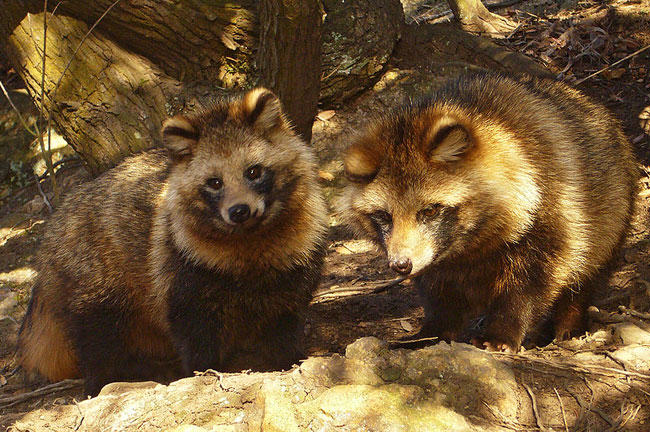
If animal welfare was really their goal, wouldn’t you think they would want a full investigation? And if this was really common practice, why has there never been another video showing this type of cruelty? (Even PETA now concedes skinning alive is not common practice, but still insists it happens on fur farms because workers are rushed. In fact, euthanized mink and other farmed fur animals are usually laid out on the wire tops of their pens to cool thoroughly before pelting; otherwise the fur can be damaged or fall out after tanning.)
Combined with the facts outlined above, the only reasonable conclusion is that the cruel actions shown in this video were staged for the camera. That would be a sick thing to do, but it wouldn’t be the first time.
The film that launched the first anti-seal hunt campaigns, in 1964, showed a live seal being poked with a knife – “skinned alive”, the activists cried! But a few years later the hunter, Gustave Poirier, testified under oath to a Canadian Parliamentary committee of enquiry that he had been paid by the film-makers to poke at the live seal, something he said he would otherwise never have done. [For more on this, see Alan Herscovici's book, Second Nature: The Animal-Rights Controversy (CBC 1985; General Publishing, 1991), pg 76.]
The moral of the story? No matter how you look at it, even from the perspective of self-interest and "greed", it is ridiculous to claim that animals are skinned alive. Now you know. And so do our activist friends who monitor these pages.
UPDATE: "Film denouncing fur deemed 'staged' by IFF investigators". Women's Wear Daily, March 5, 2019. Watch an IFF video exposing the fake here:
* * *
EDITOR'S NOTE: Due to a large volume of comments received in September 2016 that contributed nothing to the discussion, we have chosen to close comments for this post.
5 Questions to Ask Before Donating to Charity
by Alexandra Suhner Isenberg, former Online Communications Director, Truth About FurWe’ve done our fair share of ranting about two well-known animal “rights” charities on this blog so I thought it…
Read More
We’ve done our fair share of ranting about two well-known animal “rights” charities on this blog so I thought it was time to talk about donating to charity. There are many wonderful charities doing good deeds for people, animals, and the environment and they need the public’s support. There are also quite a few charities that aren’t very effective at what they do, or mislead the public about their activities.
If you are looking to donate money, and you want to feel confident the funds are going to good use, you may want to ask yourself these five questions about a charity before making a donation.
1. What are the primary services they provide? This should really be the primary reason why you are donating to a charity – because you want to help someone or something. But it is important to know exactly what the charity is doing, especially if it isn’t obvious in the name (or the name is misleading). You may also want to investigate if there are different branches or offices you can donate to. For example, the World Wildlife Fund allows you to donate to help the rhinos, tigers, or other species in need. If you have the choice of directing your funds to a specific project, then be sure to choose the one that is most important to you.
2. Are the programs effective? (And how is effectiveness measured?) This will require a bit of detective work but asking a charity outright how they measure their successes and whether they deem recent programs to have been successful is a great start.
3. What percentage of the dollar goes to providing the services and programs, versus administration or fundraising fees? A good benchmark is 60% - if the charity is spending less than 40% on administration and fundraising then the charity can be considered to be using its donations effectively.
4. How are they rated? There are lots of websites rating charities, using different criteria. Two major websites rating charities are Charity Navigator and the AIP’s Web site, Charity Watch (this site requires a $50 per year membership.)
SEE ALSO: WHY I WISH I DIDN'T LOATHE ANIMAL RIGHTS ACTIVISTS
5. What do the press say about them? A simple online search of your chosen charity can expose you to a lot of positive and negative information about their activities. It’s important to be as objective as possible, which is not always easy. Usually a simple search will help to figure out whether your chosen charity has a good reputation. There are organizations who expose the underhand or misleading activities of People for the Ethical Treatment of Animals or The Humane Society of the United States - so if you are considering donating to either of these two charities, you may want to do some research at PETA Kills Animals or Humane Watch, first. Or maybe just donate to your local shelter, instead.
Here's some further reading on the topic, if you are looking to dig deeper:
New York Times: How to Choose a Charity Wisely
Charity Law Information Program: How to decide which charity to support
EU Sealing Policy Is Hypocritical, Anti-Democratic
by Jim Winter, founding president, Canadian Sealers AssociationThe European Union recently announced that products made from seals hunted by Inuit people can continue to be sold in the…
Read More
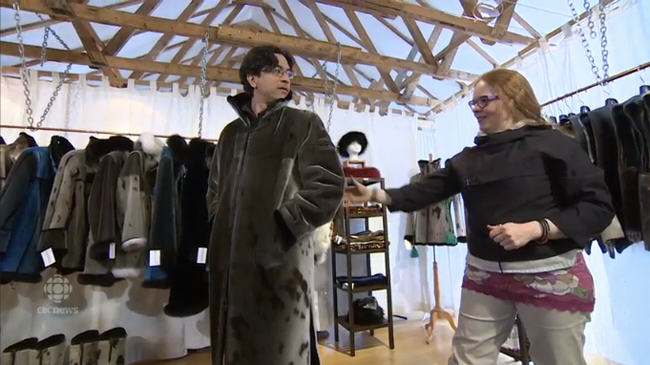
The European Union recently announced that products made from seals hunted by Inuit people can continue to be sold in the EU despite the 2009 ban that prevents the importation or sale of all other seal products. It is impossible to imagine a sealing policy that would be more hypocritical and anti-democratic.
Canadian sealing is a sustainable use of a natural resource carried out by licensed, well-trained sealers under the rules and regulations of the government of Canada, which have been developed based upon both population science and humane killing techniques. In 1971 a quota management program was established for the Northwest Atlantic harp seal stock, and the population is estimated to have grown since then from 1.8 million to the 5.9 million, according to the IUCN. World-wide the population is close to 8 million, with "All known stocks ... increasing in number".
Despite the comments of the animal rights groups, the world-wide markets for seal products (food, Omega-3 fatty acids, oil, fur, leather) continue to exist. They exist but are inaccessible because the decades-old animal rights propaganda campaigns have co-opted (bought?) politicians in the EU, the USA, and other countries to deny their citizens their democratic right to choose to buy seal products.
Even in its stronghold of North America, surveys suggest the animal rights philosophy (i.e., no animal use) is adhered to by less than 3 percent of people. And because of this lack of popular support, animal rights groups can only further their agenda by using their multi-million-dollar war chests to lobby politicians to pass laws denying citizens their right of choice: anti-democratic to say the least. Like autocrats throughout history, it seems that these wealthy activist groups don't trust individual citizens to do "the right thing".
Hypocrisy Everywhere
The World Trade Organisation enquiry found that the “seal ban” was against its rules, but in the interest of protecting the “morals” of EU citizens the ban would stand: thus buying into the animal rights propaganda that killing seals is immoral. An interesting decision given that many countries within the EU continue to kill seals legally in the Baltic and North seas.
The USA continues to allow harvesting of northern fur seals in the Pribilof Islands, creating an exemption to its own Marine Mammal Protection Act (MMPA), despite the fact that the IUCN lists the species as "vulnerable" and cautions that the Pribilof stock "has experienced a significant, steep decline in recent years." Yet it bans the importation of Canadian seal products under the same MMPA, despite the fact that the harp seals killed have never, ever been on any reputable list (the Convention on International Trade in Endangered Species, for example) of endangered or threatened species. Hypocrisy reigns supreme.
SEE ALSO: 5 REASONS WHY I SUPPORT THE CANADIAN SEAL HUNT
Inuit "Exemption" Almost Racist
Animal rights groups constantly make pious, politically correct statements that they are not against Inuit sealing. For decades, Inuit organisations (including the Inuit Circumpolar Council, or ICC, which represents Northern Aboriginal communities around the world) has rejected this “exemption” as being meaningless, based in a colonialist mentality, and little short of racism.
Thousands of rural Canadian citizens are directly and indirectly employed in the sealing industry earning a living for their families. Sealing is part of an annual mosaic of income for rural Canadians whose money is derived from a number of individual activities that in total provide a livelihood that enables them to live in their communities. The same thing applies to Canadian farmers, ranchers, trappers, hunters, and so on: the only difference is the species killed. Few rural Canadians have the luxury of a guaranteed annual salary.
SEE ALSO: AMAZING FACTS ABOUT FUR: DRESSING FOR THE ARCTIC
Animal rights groups keep on about a “buyout” for those in the sealing industry. A one-year buyout? A two-year buyout? Or an annual buyout till all those involved have died? For whom? For sealers, plant workers, truckers, diesel suppliers, insurance agents, garment manufacturers, artists, artisans, grocery suppliers, gun and ammunition stores, vehicle sales people? For all or only some of them? Will they pay the many millions involved? No. These American-headquartered multi-million-dollar groups want the Canadian tax payer to subsidize their ridiculous views.
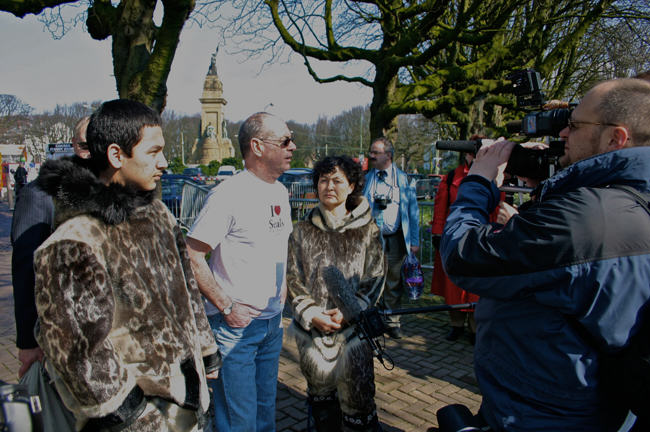
Resource Use Is Not Disneyland
"Baby seals"? The use of the word "baby" is simply an anthropomorphism, the Bambi syndrome, designed to influence and upset urban people who have a total disconnect with the sources of their food, clothing, medicines and other objects of daily use. The seals killed are fully weaned, are independent of their dames, and are on their own to survive or not: this is nature, not Bambi in Disneyland.
Death by gunshot or hakapik is instantaneous as found by innumerable studies by independent vets from Canada, the USA and the EU. The only negative studies have been bought and paid for by animal rights groups. The reality is that no animal-killing is pretty: it is by nature ugly. But pretty and ugly are not synonyms for right and wrong or good and bad. Sealing is simply an outdoor abattoir without the offal problems of land-based abattoirs (dumping it in landfills) because what we cannot use we leave on the ice to return to the eco-system as food for birds, marine mammals, fish and crustaceans: ecologically correct and green.
Travesty of Fiction Over Fact
The reality of the 50 years of animal rights propaganda has been the diminution of the incomes of thousands of Canadian citizens while these American-headquartered groups have collected hundreds of millions of dollars from people who think they are supporting animal care and conservation. One group alone generates contributions close to $100 million annually.
To adapt Winston Churchill's famous turn of phrase, never have so many been so misled by so few for such nefarious reasons. For decades these groups have said nothing new, yet their comments are deemed “newsworthy”. They and their celebrity friends utter ridiculous comments and no journalists challenge them. It's a circus, a travesty of fiction over fact, and proof that hypocrisy reigns supreme. It is media manipulation of the highest order.
Propaganda is an insidious thing and unless countered by a free press prepared to ask the hard questions it will continue ad infinitum. It is time for individuals, politicians and media to remember the immortal line of Pogo: "We have met the enemy and he is us."
The anti-sealing story is the second greatest propaganda campaign of the last 85 years. Democracy is about the right of citizens to choose. History has shown us that when propaganda triumphs, democracy loses.
Nobody in the Canadian sealing industry wants people to buy their products if they do not wish to. Canadian sealers only want all citizens to have their democratic right to choose for themselves to use or not use seal products.
Animal rights is not animal conservation or animal welfare. The goal of animal rights groups like the Humane Society of the US (and its extension, Humane Society International) and People for the Ethical Treatment of Animals, to name but two, is not to end sealing but rather to end man’s use - not just killing, but any use - of all animals for any reason. Read their mission statements. Seals are the tactic not the goal.
Anti-sealing is the epitome of George Orwell’s position in Animal Farm: all animals are equal but some animals are more equal than others.
The animal rights anti-sealing movement may have won some battles but not the war. If it wins the war you will have to look around to see whom among you will be the next victim. The beef, pork, chicken or lamb producers? The trappers, hunters or fur farmers? The clothes manufacturer, shoemaker, auto manufacturer or furniture manufacturer? Anyone who uses animals for any purpose at all? You?

Mink Liberation : 5 Facts the ALF Doesn’t Want You to Know
by Alan Herscovici, Senior Researcher, Truth About FurWhat really happens when misguided animal-rights zealots break into fur farms, cut fences, open cages and “liberate” mink? Here are five…
Read More

What really happens when misguided animal-rights zealots break into fur farms, cut fences, open cages and “liberate” mink? Here are five facts about "mink liberation" the Animal Liberation Front (ALF) and their activist cheerleaders don’t want you to know!
1. Most “liberated” mink don’t enjoy their “freedom” for long!
Farmed mink are not wild animals. They have been raised in captivity for more than 100 generations - that’s more than 2,000 years in human terms - and are ill-equipped to fend for themselves in nature.
In fact, farmed mink have been selectively bred to be less aggressive and have never had to hunt for their food. Many “liberated” mink therefore die from dehydration or starvation. And because they associate the sound of vehicles with the arrival of the farmer’s motorized feed cart, many are attracted to roads where they are run over by cars.
In their boastful press releases, activists never show the mangled results of these deadly encounters. The media also generally choose to protect public sensibilities. But mink farmers are left to clean up the remains of animals they cared for since birth.
The carnage is not pretty, but we decided that the public has a right to see the truth about these mink “liberations”. I took the following picture last Fall on the road outside a Quebec mink farm, the day after activists broke in and released several hundred mink. So far, no one has been charged for intentionally subjecting mink to the suffering you see here:
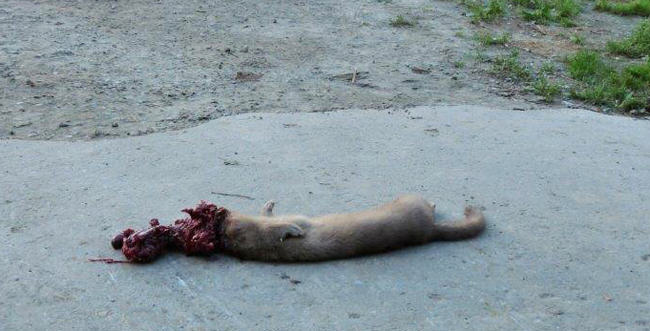
2. Mink that do survive, wreak havoc on local livestock and biodiversity
Inevitably, some “liberated” mink do survive, at least for a while, and especially if neighbours keep an outdoor chicken run or duck pond! The results are not good for the chickens and ducks.
Mink are notorious for going into a murderous feeding frenzy when the opportunity arises; they will bloodily wipe out dozens of hens or ducks within minutes.
Even more worrisome for biologists is the potential for the transmission of disease, to and from wild populations, and the possibility of weakening the gene pool if even a few domesticated mink survive long enough to mate with their wild cousins.
3. Releasing nursing females is just plain stupid!
Releasing farm-raised mink is never a good idea, but it takes a special sort of idiot to break into a farm while the females are nursing their young. This is exactly what some still-unidentified pea-brains did last month in southern Ontario. During the night of May 30-31, they cut the perimeter fence of a mink farm near the town of St. Mary’s and opened the cages of 1,600 nursing females.
The young kits, just 2-4 weeks old, are completely dependent on their mothers. With little or no fur (some still won’t even have their eyes open), they can easily die from hypothermia or dehydration. The farmers spend long hours in the barn through this critical period, to ensure that the kits are nursing and well cared for.
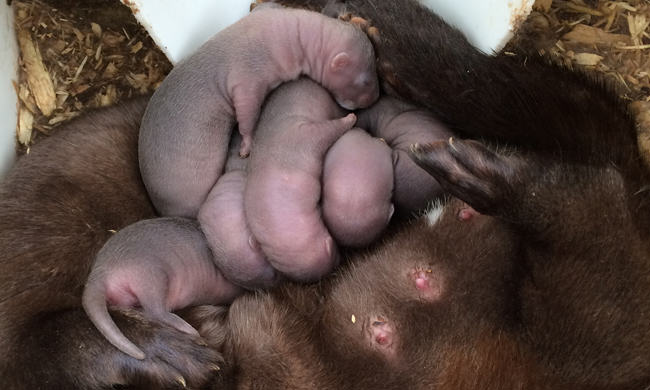
Luckily, most of the females "liberated" in St. Mary's did not go very far when their cages were opened, precisely because their young kits were nearby. So most of the females were quickly rescued, but there was no way of knowing which litters belonged to which!
Farmers will sometimes move nursing kits from large litters to be adopted by a female with fewer young. But this is done slowly and carefully, to ensure that the female will accept her new charge. But in St. Mary's, there was no choice but to return the females to cages at random, and hope that their maternal instinct would win out.
4. The livelihood of small family farms is put in jeopardy
A farm invasion is clearly very damaging: the female mink have been fed and cared for since the previous year, and the kits represent the income needed to cover these and other expenses. The damage to the livelihood of the farm family, however, goes far beyond these immediate losses.
The success of a mink farm is directly related to the quality of the fur produced. Fur quality, in turn, is determined by nutrition and care, but also by genetics. Each year, mink farmers carefully select the animals they will retain for reproduction; they are constantly working to improve the quality of their herd.
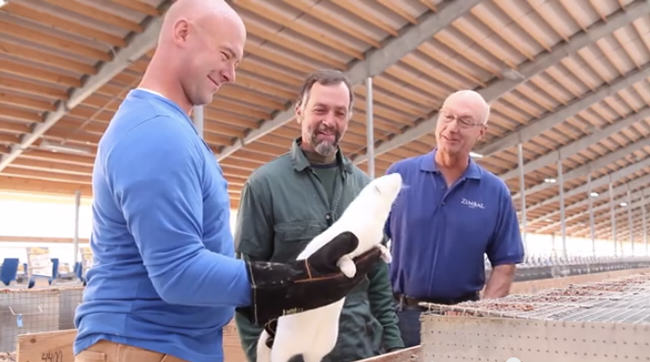
Tragically, although most “liberated” mink are quickly recovered, their genetic history is usually lost. Breeding records are kept on cards attached to the mink pens. But there is no way to know which pens the recovered mink were released from. Since many North American farms are now operated by a second or third generation of the family, decades of genetic records - and work - are lost.
ALF criminals know all this: on their websites they brag about destroying breeding records and encourage others to do the same. How can these misguided activists claim to be “non-violent” when they destroy the life-work of several generations?
5. Mink “liberations” are a direct attack on democracy and everyone’s freedom!
The recent attack on the St. Mary’s, Ontario mink farm occurred on a weekend billed by radical extremists as “a day of direct action”.
Responsibility for the attack was claimed by an anonymous group in a "communiqué" (ALF's preferred term for a press release) posted by the “Animal Liberation Press Office”.
SEE ALSO: AFTER 50 YEARS, FUR TRADE TURNS TABLES ON ACTIVISTS
The communiqué makes chilling reading for anyone who values democracy and personal freedom. In addition to the muddled collection of misinformation (e.g., claims that farmed mink are “mercilessly trapped in painful leghold traps” and suffer “a painful and agonizing death” on farms), the text states openly that Animal Liberation Front activists are using “economic sabotage” to raise costs for people working with animals, with the goal of putting them out of business.
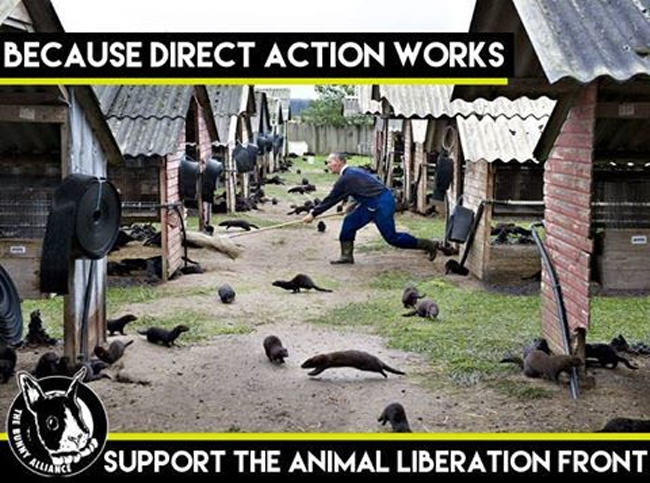
On a personal level, farmers and their families are being terrorized by these attacks on their property, their animals and their livelihoods. (Intruders are sometimes armed with baseball bats and other weapons.) On a broader level, it is all of society that is threatened by people who think their beliefs give them the right to break into private property and sabotage legal businesses.
And what do mainstream animal activist groups say about such criminal activity? Unfortunately, they often resort to Orwellian doublespeak: “We do not support illegal activity,” they insist. “But we understand why some people feel the need to stop this industry at any cost!”
Nice try. But we can turn this doublespeak on its head: if mainstream groups did not play so fast and loose with the facts in their verbal attacks on the fur trade, perhaps impressionable young activists would not be lured into such criminal activity!
***
What else do you think ALF doesn't want us to know about mink "liberation"? Please leave a comment below! And see what Fur Commission USA has to say about mink "liberation".
Lefty Tree-Lover Catches Fur Bug
by Alexandra Suhner Isenberg, former Online Communications Director, Truth About FurI’ve been told I’ve caught the “fur bug”, and I couldn’t agree more. I’m not only in love with this…
Read More

I’ve been told I’ve caught the "fur bug", and I couldn’t agree more. I’m not only in love with this beautiful, natural material, but I’m also attracted by the industry. People living off the land, small family businesses, and the fact that I’m welcomed with open arms in farms, auction houses and design studios around the world, make me so happy to be a part of the international fur family.
But there’s been one thing that’s been annoying me and I think it's time to set the record straight.
Tree Huggers and Lefties
As a campaigner for fur, I’ve been called a few nasty things by animal activists, but what annoys me most is when people in our trade refer to “tree huggers” and “lefties” as being the enemies of the fur trade.
For the record, I’m not what you would call a “tree hugger” (I find that people are much better for hugging!), but I am a tree lover and I’m sending as much love as possible towards the forests. I love nature and I want to protect it, and it strikes me as so strange that animal activists are referred to as “tree huggers” as an insult.
Aren’t all you hunters, trappers and farmers also tree "huggers” or lovers in your own way? You want to protect the land and nature too, don’t you? Where will we hunt and trap if all of the forests are cut down?
Proud to Be Left
When it comes to politics, I’m definitely “left of center” and proud of it. So are a lot of people working in the fur industry, notably Mark Oaten, CEO of the International Fur Federation.
Mark is a former senior member of the Liberal Democrats, the third-largest political party in the UK. To clarify for those of you not familiar with British politics, the Lib Dems make the US Democratic Party look like Tea Party activists by comparison.
And yet ... he and I, and many other “lefties”, love fur and dedicate a part of our lives to ensuring that this industry thrives and grows.
So why the "leftie" jibes? Why do some of us use “tree hugger” as an insult?
SEE ALSO: WHY I WISH I DIDN'T LOATHE ANIMAL RIGHTS' ACTIVISTS
Let’s save our insults for the people who are trying to destroy the industry we love.
Just because I’m a staunchly left, female, half-Muslim immigrant that loves trees, doesn’t mean I can't also succumb to the fur bug. It doesn't mean I can't also love fur, farmers, trappers, and the wonderful history and traditions of this industry.
Let’s embrace the diversity of the international fur family and use our energy to ensure that this industry thrives and continues to succeed for as many years as people have been wearing fur. That’s a long time, by the way.







